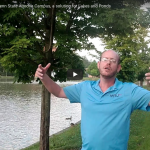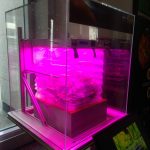#34: Underhill Permaculture: Parts 1-3, a walkabout an old American farm.
Lennox: (Bird Song).
Hi All, Colin here. So I’ve been learning Permaculture for awhile.
I don’t hold a certification of any kind, not from any organization. I went to Penn State for Environmental Studies and English, been doing biofilm reactor research for about 9 or ten years. Those who have been watching the things we’ve been doing [know] its pretty cool.
But one of the places that you get a chance to learn, of course is, a farm. You got to learn by doing; the best way. I’m out here at Underhill Farm, Churchill and Stoel are the owners, two good friends of mine. That’s Chuckles. Charlie. Little Bear. Now he has to go poo. Of course, good timing. This has been a farm in Fred’s [Stoel] family since the 1830’s.
Lennox on top of North Hill: Hi All, Colin Here at Underhill Farms, Leicester Longwools and Angora Goats. The fellows are on the trail and they have me come in and watch the farm, which is one of the best jobs I’ve ever had in my life, just throwing that in there. And I was thinking here, just a couple of minutes ago, you know, what is a farm like with no electricity? Well, this is it. This [farm] has been in Fred’s for about [190] years. That’s a little before the invention of electricity, or at least before the useful harvesting of it, so you had to be good at picking a landscape to have a successful farm.
[Pan left] What you see now is corn, lots and lots of corn. And they then bale these fields here, I’m assuming for cow[s] and other ungulates. I want to go over a couple of the [land forms and techniques] that this farm does right, just by rote. It’s had enough time, and you know, generations and generations even before this place was built, of farming techniques. We’re talking almost two hundred years ago, everybody was [a] farmer. You had to take care of your own sustenance. So knowing how to pick a landform, or take advantage of a landform.Really the basic things you need are [water, i was sick and not at my best =]. This is interesting because you can actually see the entire watershed of this one farm. The hill goes back up over here [pan left] and kind of cuts down and over [pan right] drops down, good for walks day or night, to a collection point where they have a [spring house and well]. Now it’s about 4pm, sun is starting to go down and west is off that direction [pan right from a general south face].
This [valley] is an enormous anticline. Kinda looks like the prow of a ship from space or on good topographicals. We’re in central Pennsylvania just south of Hollidaysburg. Hollidaysburg is back over in that direction. See the alleghenies? That’s wopsononock off in the distance there, and I’m in West Loop. And there is one road that runs all the way around this great valley and I’ve walked up to the top there, and over, Roaring Spring is just on the other side. And then if you follow this mountain [pans along the anticline’s east side that cuts north for ten miles] along the ridge there, it goes to Canoe Creek [State Park]. They are pretty rare landforms but what they do here is make some of the best agricultural land in the world, long as you don’t strip everything bare. Thats all state game lands there on the mountain, from the bottom of the mountain pretty much all the way up and over to the other side. As far as talking north and south directly…
Please Keep Watching for more on the secrets of Underhill Permaculture. Cheers! Colin
Call 1-814-937-9115 for consultations, questions, or local farm sitting, or, email info@ecoislandsllc.com.





